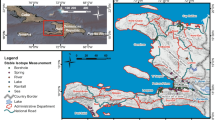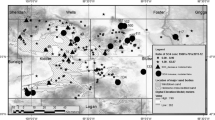Abstract
The objective of this study was to comprehensively evaluate and interpret hydrogeochemically the extensive legacy surface-water data for the expansive Republican River watershed in southcentral Nebraska. Historical (1968–1991) hydrochemistry data [major cations and anions, total salinity [specific conductance (SC)] and pH supplied by the Nebraska Department of Environmental Quality and the US Geological Survey were hydrogeochemically and statistically analyzed. Interpretation of this large legacy dataset (315 sample analyses at 12 Republican River sampling stations) revealed that the Republican River’s range in SC is relatively low (200–1020 µS/cm), with a river-wide median of 587 µS/cm (~ 380 mg/L). The range in SC for 10 tributaries (204 sample analyses) is 190–2910 µS/cm with a median value of 550 µS/cm (~ 360 mg/L). The Ca–HCO3 hydrochemical facies dominates throughout the watershed followed by the Na–HCO3 facies. Hydrochemical equilibrium modeling reveals that most samples occurred in an aqueous environment characterized by gypsum undersaturation but slight calcite and dolomite supersaturation; low supersaturation values comprise a line of evidence for the thermodynamic equilibrium or near equilibrium of the studied surface waters. Scatter plots of meq/L concentrations for selected anions and cations reveal the impact of silicate mineral (e.g., feldspars) weathering on the aqueous hydrochemistry throughout the watershed. These ubiquitous feldspar minerals most likely originated along the eastern slope of the Front Range during Late Cretaceous time (Laramide Orogeny) and were subsequently transported into the study area. The relatively high concentrations of sulfate and sodium in numerous samples collected from the Arikaree River probably originate in the underlying Pierre Shale, rich in S-bearing minerals.









Similar content being viewed by others
Data availability
Some or all hydrochemical data that support the findings of this study are available from the author through email upon reasonable request.
Code availability
All software used is in the public domain, is free, and is available to everyone.
References
Al Farrah N, Martens K, Walraevens K (2011) Hydrochemistry of the Upper Miocene-Pliocene Quaternary aquifer complex of Jifarah plain, NW Libya. Geol Belgica 14:159–174
Allison JD, Brown KJ, Novo-Gradac DS (1991) MINTEQA2/PRODEFA2, A geochemical assessment model for environmental systems. Version 3.0 User’s Manual, Environ Research Laboratory, Office of Research and Development, USEPA, Athens, p 107
American Park Network (2020) Swanson Reservoir (Trenton Dam) http://www.ohranger.com/swanson-reservoir-trenton-dam. Accessed 13 Oct 2020
Appelo CA, Postma D (1994) Geochemistry, groundwater and pollution. A.A. Balkema, Rotterdam, p 355
Atkinson JC (2011) Geochemistry analysis and evolution of a bolson aquifer, basin and range province in the southwestern United States. Environ Earth Sci 64:37–46
Atkinson JC (2012) Geochemical evaluation of sulfate levels in Ponca Creek, northeastern Nebraska. Env Geosciences 19(1):33–44
Atkinson JC (2015) Impact of the Dakota Aquifer on major-ion chemistry of Rock Creek discharge, eastern Nebraska, Midwest region. Environ Geosci 22(1):19–33
Atkinson JC (2018) Evaluation and interpretation of historical major-ion chemistry for the Lodgepole Creek watershed, Nebraska. Environ Earth Sci 77:23
Atkinson JC (2019) Interpretation of storage and retrieval major-ion chemistry, with emphasis on significant sulfate and sodium concentrations in the White River watershed, northwestern Nebraska, United States. Environ Geosci 26(2):51–71
Back W (1960) Origin of hydrochemical facies of ground water in the Atlantic Coastal Plain. In: Proceedings of 21st International Geological Congress, Copenhagen, 87–95
Back W (1966) Hydrochemical facies and ground-water flow patterns in the northern part of Atlantic Coastal Plain. Prof. Paper 498-A. US Geological Survey
Bartos T, Ogle KM (2002) Water quality and environmental isotopic analyses of groundwater samples collected from the Wasatch and Fort Union Formations in areas of coalbed methane development—implications to recharge and ground water flow, eastern Powder River Basin, Wyoming. Water-Resources Invest. Rep. 02–4045. US Geological Survey
Bentall R (1991) Facts and figures about Nebraska Rivers. Conservation and Survey Division, University of Nebraska-Lincoln, 16 p http://digitalcommons.unl.edu/conservationsurvey/156. Accessed 21 Oct 2020
Cerling TE, Pederson BL, von Damm KL (1989) Sodium-calcium ion exchange in the weathering of shales: implications for global weathering budgets. Geology 17(6):552–554
Chung SY, Senapathi V, Rajendran R, Selvam S (2020) Processes and characteristics of hydrogeochemical variations between unconfined and confined aquifer systems: a case study of the Nakdong River Basin in Busan City, Korea. Environ Sci Pollut Res 27:10087–10102
Datta PS, Tyagi SK (1996) Major ion chemistry of groundwater in Delhi area: chemical weathering processes and groundwater flow regime. J Geol Soc India 47:179–188
Dehnavi AG, Sarikhani R, Nagaraju D (2011) Hydrogeochemical and rock water interaction studies in east of Kurdistan, N-W of Iran. Int J Environ Sci Res 1(1):16–22
Diffendal Jr. RF, Mohlman DR, Corner RG, Harvey FE, Warren KJ, Summerside S, Pabian RK, Eversoll DA (2002) Educational Circular 16. Conservation and Survey Division, University of Nebraska-Lincoln, p 25
Ellis MJ (1981) Hydrogeologic reconnaissance of the Republican River Basin in Nebraska. Water Resources Invest., Open-File Report 81–531. US Geological Survey
Engberg RA (1984) Appraisal of data for ground-water quality in Nebraska. Water-Supply Paper 2245. US Geological Survey, p 54
English J, Johnston ST (2004) The Laramide Orogeny: what were the driving forces? Int Geol Rev 46:833–838. https://doi.org/10.2747/0020-6814.46.9.833
Eversoll DA, Dreeszen VH, Burchett RR (1988) Bedrock geologic map showing the configuration of the bedrock surface, McCook 1° × 2° quadrangle, Nebraska and Kansas, and part of the Sterling 1° × 2° quadrangle, Nebraska and Colorado. Miscellaneous Investigation Series, Map I-1878, 1:250,000. US Geological Survey
Fenneman NM (1946) Physiographic divisions of the conterminous United States. Special Map Series, scale 1:7,000,000. US Geological Survey
Freeze RA, Cherry JA (1979) Groundwater. Prentice-Hall, Englewood Cliffs, p 84
Goeke JW, Peckenpaugh REC, Dugan JT (1992) Hydrogeology of parts of the Twin Platte and Middle Republican Natural Resources Districts, southwestern Nebraska. Nebraska Water Survey Paper 70, Conservation and Survey Division, University of Nebraska-Lincoln, p 89
Gomaa MA, Hamouda ME, Abdelfattah MM, Emara MM, El-Sabbah MMB (2013) Assessment of hydrogeochemical processes affecting groundwater quality in the area between Safaga and El-Quseir, eastern desert, Egypt. Middle East J Appl Sci 3(4):129–142
Gustafsson JP (2009) Visual MINTEQ, Version 2.62. KTH School of Architecture and Built Environment, Dept. of Land and Water Resources Engineering, Stockholm
Hem JD (1992) Study and interpretation of the chemical characteristics of natural water. Water-Supply Paper 2254. US Geological Survey
Huber NW, Hoppes RR, Slama NL, Sherwood MA (1967) Soil survey of Red Willow County, Nebraska. US Dept of Agriculture, Soil Conservation Service in cooperation with the Conservation and Survey Division, University of Nebraska-Lincoln, p 52
Johnson CR, Brennan R (1960) Geology and ground water in the Platte–Republican Rivers watershed and the Little Blue River basin above Angus, Nebraska. Water-Supply Paper 1489. US Geological Survey, p 142
Katz B, Coplen TB, Bullen TD, Davis JH (1998) Use of chemical and isotopic tracers to characterize the interaction between groundwater and surface water in mantled karst. Groundwater 35(6):1014–1028
Korus JT, Howard LM (2019) Maps showing the physical hydrogeology and changes in saturated thickness (predevelopment to spring 2016 and spring 2011 to spring 2016) in the Middle Republican Natural Resources District, southwestern Nebraska. Nebraska Resource Atlas Number 12, 16 pp. + 14 plates, Conservation and Survey Division, University of Nebraska-Lincoln
Korus JT, Howard LM, Young AR, Divine DP, Burbach ME, Jess JM, Hallum DR (2013) The groundwater atlas of Nebraska. Third (revised) edition, Resource Atlas No. 4b/2013, Conservation and Survey Division, University of Nebraska-Lincoln
Mackenzie FJ, Garrels RH (1965) Silicates: Reactivity with sea water. Sci J 1505:57–58
Mayo AL, Loucks MD (1995) Solute and isotopic geochemistry and groundwater flow in the Central Wasatch Range, Utah. J Hydrol 172:31–59
Mitchell LE, Bowman G, Yost DA (1974) Soil survey of Harlan County, Nebraska. Soil Conservation Service (SCS), US Dept of Agriculture, in cooperation with Conservation and Survey Division, the University of Nebraska-Lincoln, p 65
NCEI (National Centers for Environmental Information) (2020) NOAA (National Oceanic and Atmospheric Administration) daily precipitation recorded for the McCook, NE, station. http://www.ncdc.noaa.gov. Accessed 3 Oct 2020
NSSL (National Severe Storms Laboratory) (2020) National Oceanic Atmospheric Administration (NOAA). https://www.nssl.noaa.gov/education/svrwx101/winter/faq/. Accessed 3 Jan 2020
Paden HE (1978) Soil survey of Franklin County, Nebraska. Soil Conservation Service (SCS), US Dept. of Agriculture, in cooperation with Conservation and Survey Division, the University of Nebraska-Lincoln
Piper AM (1944) A graphic procedure in the geochemical interpretation of water analyses. Am Geophys Union Trans 25:914–923. https://doi.org/10.1029/TR025i006p00914
Pollock RS, Davis LL (1978) Soil survey of Nuckolls County Nebraska. Soil Conservation Service (SCS), US Dept. of Agriculture, in cooperation with Conservation and Survey Division, University of Nebraska-Lincoln
Rajesh R, Brindha K, Murugan R, Elango L (2012) Influence of hydrogeochemical processes on temporal changes in groundwater quality in a part of Nalgonda district, Andhra Pradesh, India. Environ Earth Sci 65:1203–1213
Rajmohan N, Elango L (2004) Identification and evolution of hydrogeochemical processes in the groundwater environment in an area of the Palar and Cheyyar River basins, southern India. Environ Geol 46:47–61
Rieke DL, Yost DA, Culver JR, Brubacher JI (1979) Soil survey of Furnas County Nebraska. Soil Conservation Service (SCS), US Dept of Agriculture in cooperation with Conservation and Survey Division, University of Nebraska-Lincoln
ScienceDirect (2020) Potassium fertilizers, https://www.sciencedirect.com/topics/agricultural-and-biological-sciences/potassium-fertilizers. Accessed 20 Mar 2020
Social Science Statistics (2019a) Kolmogorov-Smirnov (KS) normality test online calculator. https://www.socscistatistics.com/tests/kolmogorov/default.aspx. Accessed 11 Apr 2019
Social Science Statistics (2019b) Mann-Whitney U method online calculator. https://www.socscistatistics.com/tests/mannwhitney/default2.aspx. Accessed 1 May 2019
GraphPad Software, Inc. (2016) t-test online calculator http://www.graphpad.com/quickcalcs/ttest1/. Accessed 2 May 2019
Spalding RF, Druliner AD, Whiteside LS, Struempler AW (1984) Uranium geochemistry in groundwater from Tertiary sediments. Geochim Cosmochim Acta 48(12):2679–2692
Stiff HA (1951) The interpretation of chemical water analysis by means of pattern. J Petrol Technol 3(10):15–17
Todd DK (1959) Ground water hydrology. Wiley, New York, p 656
University of New England, School of Psychology (2012) Table D. “Critical values for Pearson r.” https://webstat.une.edu.au/unit materials/c6_common_statistical_tests/testsignif_pearson.html. Accessed 21 Oct 2019
USACE (US Army Corps of Engineers) (2020) Mainstem and Tributary Reservoir Bulletin https://www.nwd-mr.usace.army.mil/rcc/reports/pdfs/MRBWM_Reservoir.pdf. Accessed 15 Oct 2020
USEPA (US Environmental Protection Agency) (2016) ProUCL software. https://www.epa.gov/land-research/proucl-software. Accessed 10 Jul 2020
USEPA (US Environmental Protection Agency) (2019) Secondary drinking water standards: Guidance for nuisance chemicals. https://www.epa.gov/dwstandardsregulations/secondary-drinking-water-standards-guidance-nuisance-chemicals. Accessed 2 Sep 2019
USGS (US Geological Survey) (1976) Hydrologic unit map—1974 State of Nebraska. Department of the Interior, US Geological Survey, Reston
USGS (US Geological Survey) (2012) GW_Chart software website. http://water.usgs.gov/nrp/gwsoftware/GW_Chart/GW_Chart.html. Accessed 9 Oct 2019
USGS (US Geological Survey) (2019) Geologic units by geographic area (state/county). https://mrdata.usgs.gov/geology/state/geog-units.html. Accessed 20 Nov 2018
Vishwakarma CA, Sen R, Singh N et al (2018) Geochemical characterization and controlling factors of chemical composition of spring water in a part of eastern Himalaya. J Geol Soc India 92:753–763. https://doi.org/10.1007/s12594-018-1098-0
Wilson JR, Stuebe AJ (2004) Soil survey of Dundy County Nebraska. Natural Resources and Conservation Service (NRCS), US Dept of Agriculture in cooperation with Conservation and Survey Division, University of Nebraska-Lincoln
WQP (Water Quality Portal) (2019) STORET data. https://www.waterqualitydata.us/. Accessed 5 Feb 2019
Acknowledgements
The author greatly appreciates the highly professional effort of Mr. Les Howard, Conservation and Survey Division, University of Nebraska–Lincoln, in preparing the CADD base map for Fig. 1 and the approval of his supervisor, Paul Hanson, PhD, Associate Director and Professor, to prepare this map. This article is dedicated to my parents—Don and Mildred Atkinson.
Funding
No funding was received for conducting this study and preparing the paper.
Author information
Authors and Affiliations
Contributions
The author made 100% of the contributions to produce the study and paper.
Corresponding author
Ethics declarations
Conflict of interest
The author has no conflicts of interest or competing interests to declare.
Additional information
Publisher's Note
Springer Nature remains neutral with regard to jurisdictional claims in published maps and institutional affiliations.
Retired. Certified Professional Geologist (CPG-07347) conferred by the American Institute of Professional Geologists (AIPG).
Supplementary Information
Below is the link to the electronic supplementary material.
12665_2020_9358_MOESM16_ESM.doc
(a) Summary statistics for chemical-quality parameters, Frenchman Creek at Culbertson (USGS), (b) Summary statistics for chemical-quality parameters, Frenchman Creek at Culbertson (NDEQ) (DOCX 39 KB)
Rights and permissions
About this article
Cite this article
Atkinson, J.C. Baseline evaluation of legacy hydrochemical data for the Republican River watershed, southcentral Nebraska, USA. Environ Earth Sci 80, 77 (2021). https://doi.org/10.1007/s12665-020-09358-9
Received:
Accepted:
Published:
DOI: https://doi.org/10.1007/s12665-020-09358-9




